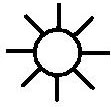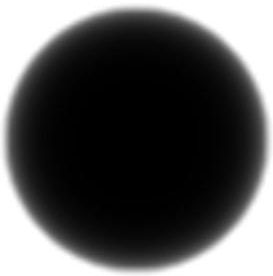|
Depict an Expansive Flood By John Ruskamp, Jr., Ed.D. © 2008 [Editor's note: Readers may want to review LaVan Martineau's table of signs which relates to this article.]
In the Western Mojave Desert of Southern California there is a panel of ancient rock art pecked into a boulder alongside an ancient lake that depicts a man in a boat1. Two other glyphs on this panel depict a flood. In this paper these three images are collectively analyzed, revealing a larger story. LaVan Martineau's rock art interpretations are utilized in this work as comparative and interpretive tools. Evidence is provided which supports the interpretation of these petroglyphs as a depiction of an expansive flood. Site Description At Little Lake, California, there is an intriguing cluster of petroglyphs that appear to have been drawn by the same artist approximately 500 to 1,500 years B.P.2 This particular set of ancient drawings, referred to in this paper as the Desert Flood Panel (Image 2), was carved on the vertical surface of a rock located approximately ten feet above the ground near the south end of Little Lake. The central image on this panel depicts a possible stickman standing above a horizontal dividing line in the top portion of an elongated U-shaped figure (Image 2). Overall, the attributes of this glyph have been shown to be significantly similar to the Chinese radical element (Figure 1) that is used to symbolize a floating vessel or boat.3 The bottom portion of this glyph contains several horizontal wavy lines that clearly depict water (Figure 2).4 Consequently, in this paper this petroglyph is referred to as the Vessel Glyph.
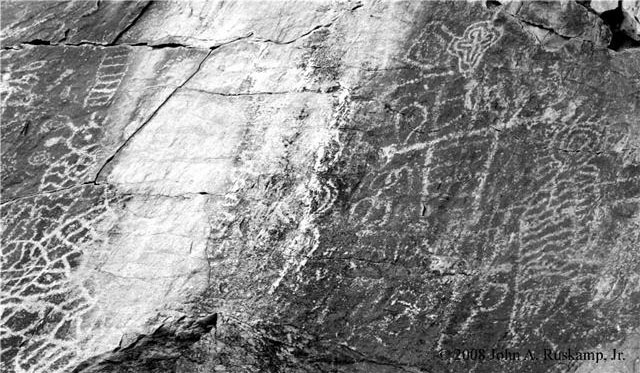 Image 1. Desert Flood Panel petroglyphs Like the Chinese radical it resembles, the Vessel Glyph is divided by a horizontal line that extends beyond each side of the figure. It is important to note that at each end of the Vessel Glyph's long line there is a large solid dot. In other settings similar dumbbell shaped rock art depictions have been interpreted as "talking."5,6 However, in this context as it is depicted in the Vessel Glyph, this figure probably does not represent speech. Rather, the dots likely represent places and the line connecting them illustrates movement as it does in the rock art symbol for "leaving," or "gone" (Figure 3).7 Thus, as an integral part of the Vessel Glyph this dumbbell shaped figure appears to record the boat's movement from one place to another, as along a time-line "from here to there." Nevertheless, the possibility that this figure depicts a conversation related to the story of the vessel cannot be totally dismissed.
 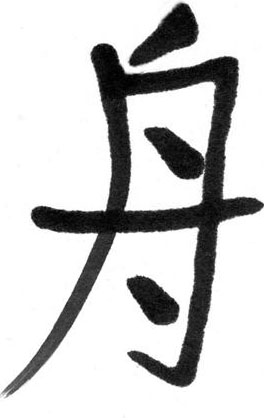 [left]Image 2. Vessel Glyph [right]Figure 1. Chinese "boat" radical Similar to the Chinese radical element used for a "boat," the Vessel Glyph has a second significant figure drawn immediately above it (Image 3). This image resembles a bird, as it has a carefully etched left-facing "beak," and there are gently upward-sloping "wing-like" lines that extend outward from it on both sides. Therefore, it is called the Bird Glyph. In addition, this glyph is surrounded by two concentric outlines that serve to magnify its importance. These outlines may denote the multiplication of the bird from one to three, or signify the importance of the enclosed figure, or both.
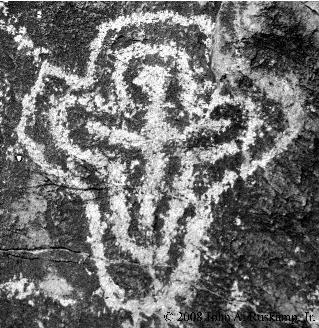 Image 3. Bird Glyph
To the lower right of the Vessel Glyph, there is a second drawing (Image 4) of about the same size and age that is composed of three distinctly different vertical sections. The bottom section of this image encloses several short vertical lines that hang from a single horizontal bar. In other rock art settings, similar depictions (Figure 4) are frequently interpreted as rain.
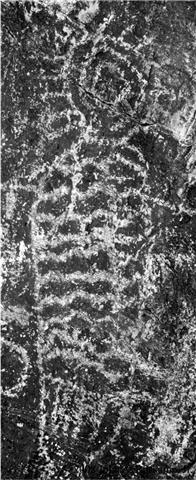 Image 4. Flood Glyph
Figure 2. "Water"
Figure 3. "Leaving" or "Gone"
Figure 4. "Rain" Immediately to the left of the Vessel Glyph is a pecked vertical line with four sets of equally spaced concentric circles drawn upon it (Image 5). Similar illustrations can be found throughout the Great Basin at petroglyph sites such as Grapevine Canyon (Image 6) and Lagomarsino (Image 7) in Nevada. Although abstract, these depictions may represent an early form of writing similar to the Incan "Kaipu String" which encoded information in a matrix of rope knots.
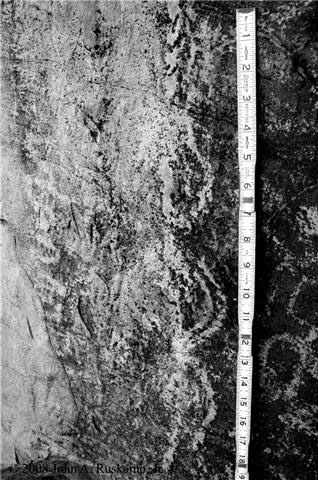 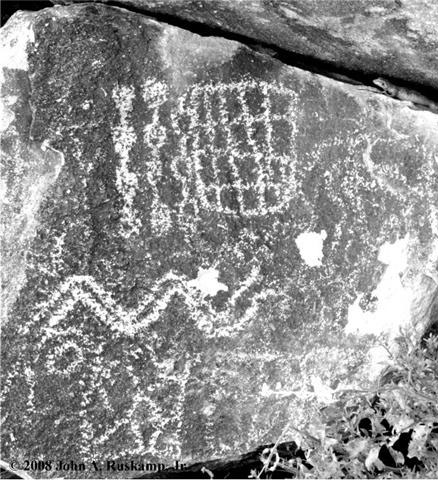 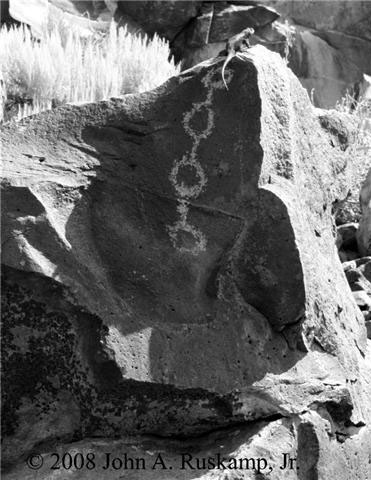 [left] Image 5. Little Lake, [center] Image 6. Grapevine Canyon, [right] Image 7. Lagomarsino Above and to the left of the four depictions of concentric circles on the Desert Flood Panel there is a very old and faded petroglyph (Image 8) which, although difficult to discern, clearly depicts a "ladder-like" figure with at least ten horizontal divisions. Below this image is another equally faded depiction (Image 9) that appears to have been made by the same artist and evidently is of the same age. This second ancient glyph is oval in shape and is filled with numerous intersecting lines. Several additional lines and possibly three figures, one of which could be the depiction of a stickman, extend downward from the lower portion of the oval. This particular petroglyph generally resembles a more recent image that was carved above the San Juan River in southeastern Utah (Image 10). Considering their central location on the Desert Flood Panel and their apparent age when compared to the more clearly defined glyphs that surround them, the information preserved by these two ancient drawings may or may not be related to the other images found on the Desert Flood Panel.
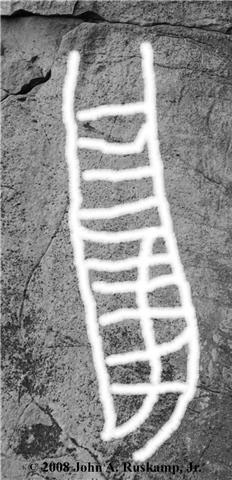 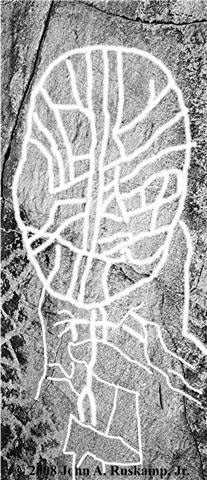 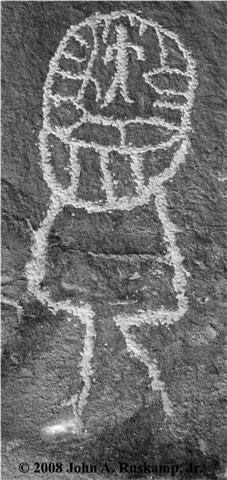 [left] Image 8. (Enhanced), [center] Image 9. (Enhanced), [right] Image 10. To the left of this old oval image on the Desert Flood Panel is a third major glyph (Image 11). It is similar, in detail and size, to the Flood Glyph. Like the Flood Glyph, this image is divided into three vertical sections, and its middle section contains numerous water lines. However, in the bottom section where the Flood Glyph depicts rain, this glyph has several vertically oriented water lines which indicate that the water is now diminishing or "moving downward."11 The top section of this petroglyph consists of a single circle surrounding a central dot. Similar drawings (Figure 7) have been interpreted by Martineau as meaning “holding in place” or noting a specific location.12 Like the Flood Glyph this circle has numerous short lines radiating outward from it. But unlike the lines that emanate from the top of the Flood Glyph, two of these lines end with a pair of hollow concentric circles, and a third line ends with a large solid dot. Respectively, Martineau interprets symbols similar to these illustrations as "nothing there" (Figure 5) and "something there" (Figure 8). Additionally, he has documented that when an image has radiating lines attached to it, the modified depiction communicates "release" or outward movement.13 Therefore, this third petroglyph is called the Dispersion Glyph.
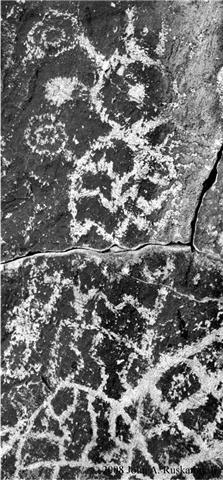 Image 11. Dispersion Glyph
Figure 5. "Nothing There"
Figure 6. "In All Directions"
Figure 7. "Holding" or "Fixed Location"
Figure 8. "Something There" Finally, superimposed over the lower portion of the Dispersion Glyph and continuing to the right of it, there is the depiction of a meandering grid-like pattern (Image 12) that possibly terminates with a third stickman figure. Based upon the level of repatination associated with these grid-like images when they are compared with the underlying Dispersion Glyph, it is evident that they were created more recently than were the Flood, Vessel, and Dispersion Glyphs, which all appear to belong to the same older era.

Image 12. Discussion Numerous depictions that are substantially similar to the Vessel Glyph have been identified at scattered sites, separated by hundreds of miles, across the Great Basin region of the American West.14 Whatever these analogous glyphs depict, the symbolic information encoded in their design must have been very important and well understood by the ancient authors/artists. Certainly, such symbolic drawings do not record an entopic or neuropsychological experience. According to Bruno David (Queen Elizabeth II Fellow and Co-Director of the Programme for Australian Indigenous Archaeology at Monash University in Melbourne): "Shamanistic interpretations (of petroglyphs and pictographs) - and there are varied formulations - have gained much influence worldwide since David Lewis-Williams' influential South African writings of the mid-1980s." Nevertheless, Bruno remains unconvinced that shamanistic/neuropsychological interpretations have any general applicability to archaeological interpretation. He states that: "The shamanistic framework has now become a problem of the hyperreal."15 To date, at all of the sites where depictions similar to the Vessel Glyph have been identified, the pre-Columbian indigenous populations spoke languages belonging to the Numic branch of Uto-Aztecan. Therefore, a linguistic framework for the analysis of these images may provide the best means for deciphering them, as the Numic people's migration into these geographical areas generally coincides with the age assigned to these similar glyphs. When the images on the Desert Flood Panel are collectively deciphered, beginning with the Flood Glyph on the panel's lower right side and ending with the Dispersion Glyph on the panel's left side, the following story is revealed. First, the Flood Glyph illustrates that rain led to an extensive flood that spread outward until it completely covered the ground so that nothing could be seen in any direction. (Note: While there is geologic evidence for periodic flooding at Little Lake the extent of these changes would not have been sufficient to obscure "everything in all directions" as the Flood Glyph indicates.) Second, the dots located at each end of the Vessel Glyph's horizontally bisecting time-line records that for a while the person in the boat floated ("was held") above the flood water. Third, the Bird Glyph that is depicted immediately above the Vessel Glyph illustrates that this animal was somehow associated with the man and the boat. Fourth, the Dispersion Glyph illustrates that it was from a fixed point, probably where the boat landed as the flood waters receded, that numerous objects began to spread outward. The two sets of concentric circles that radiate from this glyph on separate lines inform us that each of these objects found nothing. The single dot at the end of another line proceeding from the glyph illustrates that this object found something. Finally, if an anthropomorphic figure is depicted at the end of the meandering grid-like pattern the story concludes as the individual who survived the flood in the boat emerges into an uncluttered location. The individual characteristics of the major petroglyph images on the Desert Flood Panel closely align with Heizer and Baumhoff's Great Basin Curvilinear and Rectilinear Abstract styles of rock art.17 However, the symbolic nature of the information embedded in the Flood Glyph, Vessel Glyph, Bird Glyph, and Dispersion Glyph, clearly separates them from other less understood and more purely abstract rock art depictions. Consequently, these four glyphs fit best into a new category of rock art which, following Heizer and Baumhoff's rock art style nomenclature, may be called the Great Basin Symbolic. Further research into the age, distribution, and frequency of symbolic rock art such as is located on the Desert Flood Panel at Little Lake, California is highly encouraged. Endnotes 1. Ruskamp, Jr., John A. "Interpretation of North American Rock Art Using Substantial Similarity and a Biblical Paradigm as Interpretive Tools," Epigraphic Society Occasional Papers 26 (2008), in press. 2. Maturango Museum, "Little Lake Ranch Rock Art and Archaeology," (May, 2007). 3. Ruskamp, Jr. 4. Patterson, Alex. A Field Guide to Rock Art Symbols of the Greater Southwest (Boulder, Colorado: Johnson Books, 1992), 205. 5. Patterson, 86. 6. Martineau, LaVan. The Rocks Begin To Speak (Las Vegas, Nevada: KC Publications, Inc., 2003), 138. 7. Martineau, 160. 8. Patterson, 165. 9. Martineau, 49. 10. Martineau, 47. 11. Martineau, 138. 12. Martineau, 95. 13. Martineau, 95. 14. Ruskamp, Jr. 15. David, Bruno. Review of "Shamanism and the Mind: A Cognitive Approach to Archaeology," by James L. Pearson, Oceania, Vol. 73, 2002. 16. Heizer, Robert F. and Baumhoff, Martin A. Prehistoric Rock Art of Nevada and Eastern California, (Berkeley, Los Angeles, London: University of California Press, 1962), 200.
Comments:
|




